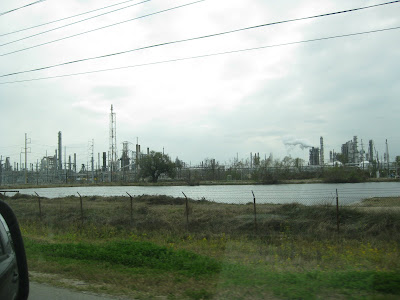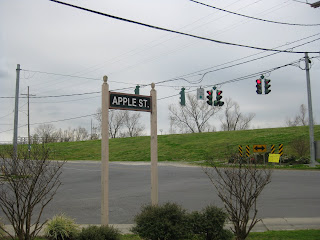We went to Norco on Saturday, February 28, 2009 at around 12:45 pm. Driving in, there didn't seem to be much around, but I noticed the obviously Katrina-damaged bayou structures on the way into Destrehan. There were houses and vehicles that were totally gutted and had clearly been moved from wherever they initially were. It seemed weired to me that
even 3 1/2 years after the storm, nobody has done anything about them, and I wondered if anyone was even planning on doing anything.
I figure it is either a cost issue or that people just don't think it's worth the trouble to fix the area. After Destrehan, it seemed as if civilization ended, and there just seemed to be the road and the bayou. Then, all of a sudden, the refinery appeared through the trees. There were multiple massive chimneys and huge clouds of steam and smoke coming from them. It seemed to take forever to drive past it, it was like a small city.
We turned onto Apple St, which seems to be one of the main roads in Norco. The houses on the street were smaller, but most of them were well kept, with nice landscaping. There were a lot of SUVs, particularly Nissans. This seemed to be a working class community where, like in Beltway, people took a lot of pride in the appearance of their homes.
There were a few industrial businesses related to the refinery, but there were also some smaller shops like an ice cream shop, a Sub Express, and a Dollar General. I also noticed at least two law offices, which struck me as odd. It seemed weird that Norco, such a tiny community, should have even one law office, let alone two. I figure there are probably many workers' compensation cases related to the refinery, but I also wonder if the refinery gets sued for many health related issues of Norco residents.
We first stopped at the Sub Express and spoke to the store owner, an Asian man who we found out actually lived in Metairie, not Norco. He told us to talk to one of his employees, Rose, who lived in the area. Rose was a 47 year old white woman (but appeared to be much older) who is the mother of two children. She grew up in New Orleans, and quit school after 11th grade. She has lived in Norco for 10 years, and moved into her sister's house there after her sister died of cancer. Rose's brother and neighbor also died of cancer, and she says that everyone in Norco seems to have some form of cancer, which she blames on the refinery. She was very bitter about the refinery, saying that they burn off toxic waste at 2 or 3 am when they think nobody will notice. She informed us that the plant bought more than 40 homes around Norco, and made it sound as if the residents had no choice but to sell their homes. Many of these residents were poor and black, and moved out of the area after selling their homes, which is why Norco has such a small black community. She also told us that the plant laid off a lot of people, many because the workers had criminal records. She also said that many of the people who work there won't say their true feelings about the refinery, because they're afraid that if they speak out against it, they'll also get fired. She did have good things to say about Shell when it came to Katrina, and told us that they helped a lot with the hurricane recovery effort, and that Shell gives a lot of money to the local schools. Rose's other main grievance was against the Norco cops. She says they're corrupt, and that they get bored and plant drugs on "youngsters" so that they have something to do. Her own son has been arrested 17 times and is currently in jail, although she is sure of his innocence. Her daughter was also arrested on drug charges, bur Rose was able to get her out of jail. She told us that on December 15, 2008, the cops arrested 98 teenagers on drug charges, and she believes that they were all innocent. Rose told us that she hates living in Norco, and that there is nothing to do there. when we asked about the general population of Norco, she told us that it's an older community age-wise, and that most people at least finish high school or get their GED. she also told ust hat there are no race issues in Norco. Rose works two jobs, and seemed to me to be very tired. Through speaking with Rose, we were able to discover that the community of Norco as a whole is mostly working class, and most people have a lower level of education. There is little to no spatial segregation, and there is a heavy police presence in the community.
After we left Sub Express, we split up into two groups. Carolyn and I walked into a nail salon, but the only woman there was very unwilling to talk to us, and only told us she didn't live in Norco. We eventually decided to go to the Dollar General, where we spoke to Tammy, a middle-aged white employee. Tammy moved to Norco in 1981 after living in New Orleans. She first told us about the explosion that happened at the plant in 1988, and she said Norco was "like a ghost town" afterwards, and that it was a really scary time to be living there. However, she also said that prior to that explosion there hadn't been one in 50 or 60 years, so she still felt safe living in such close proximity to the plant. When we asked about cancer, Tammy wasn't as quick as Rose to say that everyone she knew had cancer. Her own husband died of cancer at 29, and she does think that the cancer rate is higher in Norco than in other places, although she informed us that studies have shown that there is no actual difference. She also insisted that Norco's water is some of the cleanest water in the country, and that she feels completely safe drinking it. We also discussed the effects of Katrina on the area, and she said that there really wasn't that much damage. However, a lot of people from the surrounding flooded areas came into Norco, and that there has been a higher drug presence ever since. Tammy also elaborated on the huge drug bust that Rose spoke about, but she said only 44 people were arrested, not the huge figure Rose gave us. She said she hasn't heard anything about corrupt cops, and she personally loves them. She did however, agree with Rose that there is nothing to do in Norco, and joked that the Dollar General was the "Norco Mall." She told us there used to be more to do, but the fun hangouts like the arcade, movie theater, and skating rink all closed down. I attribute this to the fact that Norco's population is older, so businesses can't get enough teenagers with free time and money to provide their stores with business. I also wonder if since those stores closed, the kids turned to drugs for something to do.
Finally, when we asked Tammy about the plant, she was very general. She said she had nothing against the plant, and added that people are generally pretty happy with it. She said that Shell does a lot for the schools and for the community. She told us that the workers who were laid off from the plant didn't stick around Norco, but moved out very quickly. Tammy also said that a lot of out of towners come to the Dollar General, but I noticed that most of the customers and employees knew each other. They were able to engage in pretty personal social conversation, suggesting that Norco is a fairly tightly knit community.
It was also really interesting driving around Norco seeing how many parties and barbeques there were going on. We must have passed 4 or 5 parties happening outside. I noticed that there were blacks and whites interacting at these parties, and theres seemed to be no racial tension. Also interesting was the fact that even with all the health and safety concerns associated with the refinery, there was a playground and houses right next to the huge chimneys and boilers. I suppose the residents of Norco have decided they can't live in fear of the plant, and the must instead learn to exist with it as best they can.
 These two oppinions are closely related to the individual's circumstance, more specifically, where the individual lives. As we observed and one citizen pointed out, the closer one lives to the plant, generally, the lesser off, the family is. So, it makes sense that the closer a person lives to the plant, the more that that would encomapss their daily lives. Everything from health problems, to disruption via pollution burnings late at night, stems from where the person is located.
These two oppinions are closely related to the individual's circumstance, more specifically, where the individual lives. As we observed and one citizen pointed out, the closer one lives to the plant, generally, the lesser off, the family is. So, it makes sense that the closer a person lives to the plant, the more that that would encomapss their daily lives. Everything from health problems, to disruption via pollution burnings late at night, stems from where the person is located.
















































